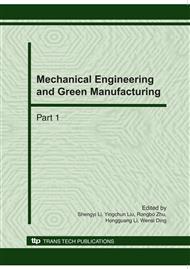[1]
J-J. Luo, I. M. Daniel, Characterization and modeling of mechanical behavior of polymer/clay nanocomposites , Composites Science and Technology, Vol. 63 (2003), P. 1607-1616.
DOI: 10.1016/s0266-3538(03)00060-5
Google Scholar
[2]
FZ. Fang, YC. Liu, On minimum exit-burr in micro cutting, J Micromech Microeng, Vol. 4 (2004), P. 984-988.
DOI: 10.1088/0960-1317/14/7/020
Google Scholar
[3]
J. Davim, J. Paulo, R. Leonardo, Ant َ◌nio. Festas, A M. Abr, Machinability study on precision turning of PA66 polyamide with and without glass fiber reinforcing, Materials and Design, Vol. 30 (2009), P. 228-234.
DOI: 10.1016/j.matdes.2008.05.003
Google Scholar
[4]
V G. Dhokia, S. Kumar, P. Vichare, S. T. Newman, R. D. Allen, Surface roughness prediction model for CNC machining of polypropylene. Proc. IMechE Part B: J. Engineering Manufacture, Vol. 222 (2008), P. 137-157.
DOI: 10.1243/09544054jem884
Google Scholar
[5]
Vimal G. Dhokia, Sanjeev. Kumar, Parag. Vichare, Stephen T. Newman, An intelligent approach for the prediction of surface roughness in ball-end machining of polypropylene, Robotics and Computer-Integrated Manufacturing, Vol. 24 (2008).
DOI: 10.1016/j.rcim.2008.03.019
Google Scholar
[6]
PG. Benardos, GC. Vosniakos, Prediction of surface roughness in CNC face milling using neural networks and Taguchi's design of experiments. Robot Comput Integr Manuf, Vol. 18 (2002), P. 343-354.
DOI: 10.1016/s0736-5845(02)00005-4
Google Scholar
[7]
Yu. Jianbo, Wang. Shijin, Xi. Lifeng, Evolving artificial neural networks using an improved PSO and DPSO, Neurocomputing, Vol. 71 (2008), P. 1054-1060.
DOI: 10.1016/j.neucom.2007.10.013
Google Scholar
[8]
Leandro dos Santos Coelho, Chu-Sheng Lee, Solving economic load dispatch problems in power systems using chaotic and Gaussian particle swarm optimization approaches, Int J Elec Power, Vol. 30 (2008), P. 297-307.
DOI: 10.1016/j.ijepes.2007.08.001
Google Scholar
[9]
Du. Weilin, Li. Bin, Multi-strategy ensemble particle swarm optimization for dynamic optimization, Inform Sciences, Vol. 178(2008), P. 3096-3109.
DOI: 10.1016/j.ins.2008.01.020
Google Scholar
[10]
Y.W. Guo, A.R. Mileham, G.W. Owen, P.G. Maropoulos, W. D Li, Operation sequencing optimazation for five-axis prismatic parts using a particle swarm optimization approach, proc. IMechE, Part B: J. Eng-ineering Manufacture, Vol. 223 (2008).
DOI: 10.1243/09544054jem1224
Google Scholar
[11]
K.W. Chau, Application of a PSO-based neural network in analysis of outcomes of construction claims, Automat Constr, Vol. 16 (2007), P. 642-646.
DOI: 10.1016/j.autcon.2006.11.008
Google Scholar
[12]
J. Salerno, Using the particle swarm optimization technique to train a recurrent neural model, in: Ninth International Conference on Tools with Artificial Intelligence (ICTAI'97), IEEE Press, (1997).
DOI: 10.1109/tai.1997.632235
Google Scholar
[13]
C.F. Juang, A hybrid genetic algorithm and particle swarm optimization for recurrent network design, IEEE Trans. Syst. Man Cybernet, Vol. 34 (2004), P. 997-1006.
DOI: 10.1109/tsmcb.2003.818557
Google Scholar
[14]
A. Guerra. Fábio, Leandro dos S, Coelho. Multi-step ahead nonlinear identification of Lorenz's chaotic system using radial basis neural network with learning by clustering and particle swarm optimization, Chaos, Solitons & Fractals, Vol. 35 (2008).
DOI: 10.1016/j.chaos.2006.05.077
Google Scholar
[15]
Qing-liang, CHANG., Hua-qiang, ZHOU., and Chao-jiong, HOU. Using particle swarm optimization algorithm in an artificial neural network to forecast the strength of paste filling material, J China Univ Mining & Technol, Vol. 18 (2008), P. 551-555.
DOI: 10.1016/s1006-1266(08)60292-8
Google Scholar
[16]
v. Kiranyaz, Ince. Turker, Yildirim. Alper, Gabbouj. Moncef, Evolutionary artificial neural networks by multi-dimensional particle swarm optimization Neural Networks, In Press, Corrected Proof, (2009).
DOI: 10.1016/j.neunet.2009.05.013
Google Scholar


